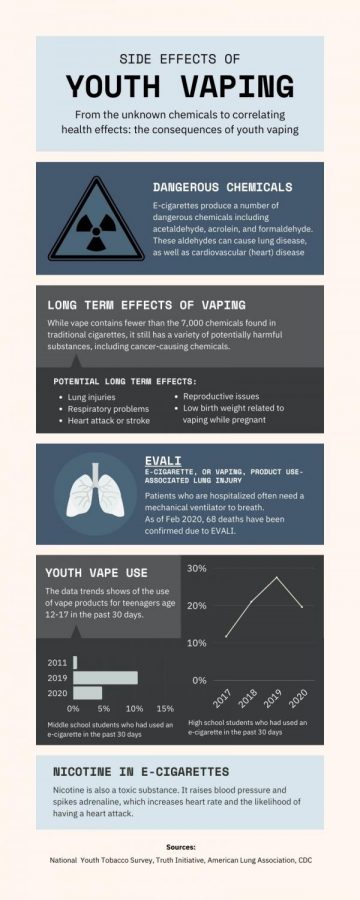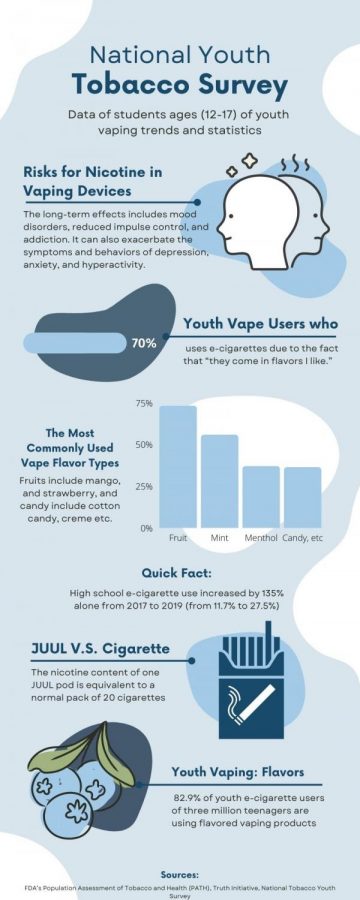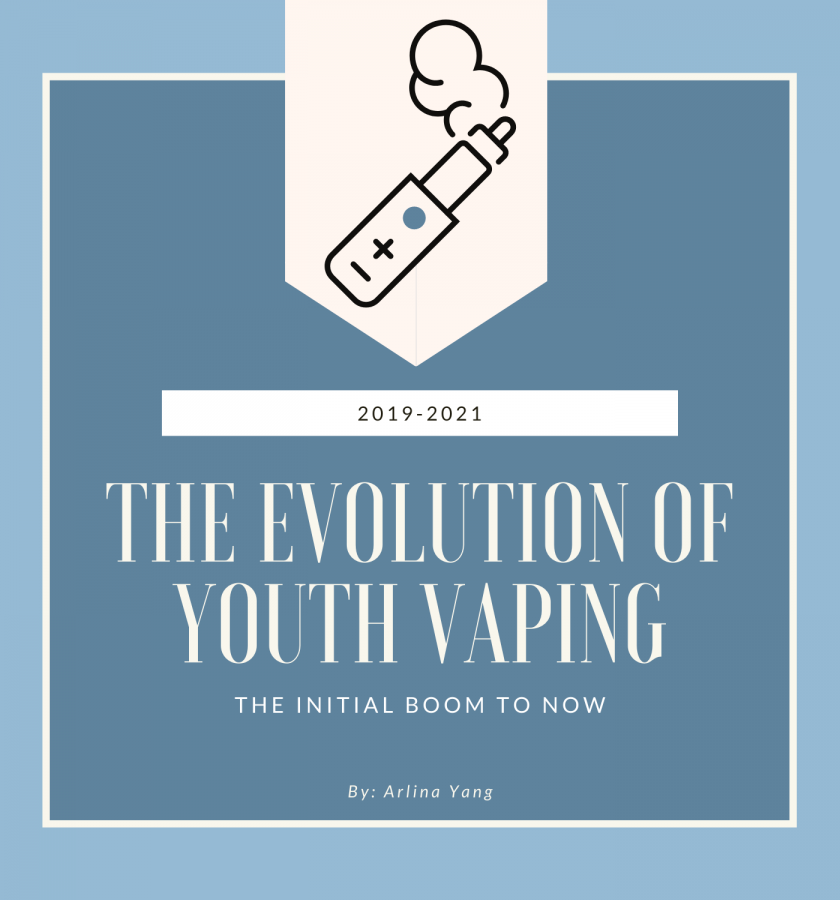The evolution of youth vaping: initial boom to now
The evolution of youth vaping from 2019-2021: a positive trend or a temporary drop.
From the initial 27.5% reported high school students who vape in 2019 to the dramatic change to 11.3% in 2021 from the annual National Youth Tobacco Survey, the use of e-cigarettes among teens is undergoing change.
While the decline occurred amidst the pandemic, the survey shows that more than 2 million high school students are still using e-cigarettes, leading to questions on whether the trend for vaping is truly on the decline or only temporary.
Skyrocketing from 2019
The 2015 debut of JUUL, an e-cigarette device, quickly caught the attention and attracted the teenagers by masses with their discreet appearance that often represents a USB flash drive. The sleek design instantly made it the go-to for teenagers alike as it’s easy to not only hide from parents but teachers at school as well.
“I’m a curious person…and being surrounded by other teenagers who vape made me want to find out what the hype is about, so I had to try it out for myself,” said Anonymous.

Research made by the National Youth Tobacco Survey (NYTS)—that included three million teenagers—reported around 82.9% of youth e-cigarette users are using flavored vaping products. Additionally to the NYTS, another survey conducted by the FDA’s Population Assessment of Tobacco and Health (PATH) found that 97% of current young e-cigarette users used a flavored product in the past month and that up to 70% of current youth users reported using e-cigarettes due to the likeable flavors.
“Flavors are no doubt one of the reasons that attracted many teenagers to vaping, like I have friends around me who like flavors such as passion fruit, strawberry, or even mint,” said Anonymous.
The booming market for flavors was the catalyst to the rapid rise in youth-vaping. JUUL’s shocking exponential growth came from the incredulous surge in youth vaping, high school e-cigarette use increased by 135% alone from 2017 to 2019 (from 11.7% to 27.5%) according to the National Youth Tobacco Survey. Another national youth survey, the Monitoring the Future Study, found that the year from 2017 to 2018 was the largest jump in increase of youth use of any substance in the 43-year history of the survey.
“In my opinion, vape tastes really bad, and I think some people do it just to look cool and to follow the ‘popular’ trend. Those kids are empty on the inside, and are starving for others’ validation,” said Anonymous.
Despite the decline in teen vaping in 2020, there are still millions of kids using e-cigarettes, a statistic that led the U.S. Surgeon General to coin the term “vaping epidemic” for the skyrocketing use of youth e-cigarettes amongst teenagers in 2018.
“We are equally disturbed by the quarter of high school students (27% of regular users in the National Youth Tobacco Survey) who use e-cigarettes and say they vape every single day,” said Mitch Zeller, the director of the FDA’s Center for Tobacco Products.
According to The Monitoring the Future Study, JUUL continued to remain a popular e-cigarette brand in 2020, but its fame has died down with it being preferred by 25.4% of users contrary to the 59.1% in 2019. The stardom ultimately dwindled due to its competitors such as Puff Bars, where 26% of the regular high school e-cigarette users from the survey opted for Puff as their go-to. and the restrictions put in place by the government to stamp down the youth vaping epidemic.
“Aside from ‘following the trend’, some teens vape for stress relief or for the flavors that were all the hype before because of all the options available to us. Vaping water was an option too, though vaping overall should not be an addiction that teenagers get into. Not only because of the science behind nicotine, but also the effects that it can bring to one’s health in the long run,” said Anonymous.
Changes made for teen-vaping
Not only did many organizations rally to combat the youth vaping epidemic, but so did many of the state governments.
It started with Michigan, who quickly became the first state to limit the sale of the flavored e-cigarettes in 2019 after youth vaping was declared a public health emergency. Followed by New Jersey, New York, and Rhode Island, who had all put bans in place on the sale of flavored tobacco products.
“Bans at some point do help, but I think if teenagers really want it—there are always ways around it,” said Anonymous.
Soon a total of eight states—Massachusetts, Michigan, Montana, New York, Oregon, Rhode Island, Utah and Washington—had issued emergency rules to temporarily prohibit the sale of flavored e-cigarettes due to the rise in youth vaping in 2019. Though the order had expired in Montana and Washington, states including Massachusetts, New York, and Rhode Island had put permanent bans in place on flavored tobacco products.

“The use of e-cigarettes and marijuana vaping products is exploding and we are seeing reports of serious lung illnesses, particularly in our young people. The purpose of this public health emergency is to temporarily pause all sales of vaping products so that we can work with our medical experts to identify what is making people sick and how to better regulate these products to protect the health of our residents,” said Charlie Baker, Governor of Massachusetts in declaration of a temporary four-month statewide tobacco ban.
California became the second state (first being Massachusetts) to restrict the sale of both flavored e-cigarettes and menthol cigarettes through the Senate Bill 793. It was written by Senator Jerry Hill and supported by the American Lung Association and the American Heart Association. The bill was signed into law in August 2020 by California Governor Gavin Newsom that officially bans the flavored tobacco products in retail. This law makes the sale of e-cigarette cartridges and flavored tobacco products subject to a $250 fine to the retailer.
“I think bringing the issue of flavored tobacco products into federal law is pretty crucial in limiting the access that teens could have to those products,” said Anonymous.
Many renowned organizations including the CDC, American Lung Association, American Heart Association, Tobacco Free Kids, and the FDA have all publicized anti-vaping marketing campaigns to the youth in attempts to reel back the effects from the teen vaping epidemic.
“I don’t think those anti-vaping ads were effective, teens wouldn’t still be vaping now if they were. I think our generation doesn’t really take anything seriously, and these ads are more so regarded with carelessness,” said Anonymous.
The campaigns such as ‘The Real Cost’ from FDA, ‘Protect Kids: Fight Flavored E-Cigarettes’ from Tobacco Free Kids, and ‘Know the Risks’ from CDC, have been published in the forms of video ads, social media posts, or posters. All of which features the effects of vaping, warnings from teenagers who once vaped, or a guide on how to stop vaping.
“I think there’s some duality that goes with the ad campaigns, to a certain degree it definitely advocates against vaping and that’s good for educating the public on vaping’s true effects. But at the same time, those who constantly get bombarded with the ad campaigns on Youtube, Instagram, heck even Quizlet, could get curious of whatever vaping is about and would want to try it out for themselves,” said Anonymous.
While youth vaping is currently on a decline according to the National Youth Tobacco Survey, it is still premature to declare it a waning trend among the teenagers. Though the declining statistics—aided by the world-stopping COVID pandemic, awareness campaigns of the risks of vaping, and enforcement of the restriction of e-cigarette sales— is nonetheless an encouraging sign of change for the young generation.
Your donation will support the student journalists in the AVJournalism program. Your contribution will allow us to purchase equipment and cover our annual website hosting costs.

